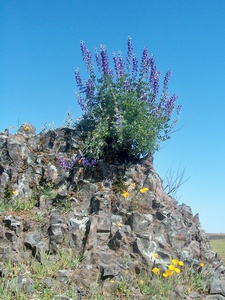 Silver Bush Lupine (Lupinus albifrons) thrives on neglect in the wild, gravitating toward sharp drainage and sometimes rooting into exposed bedrock. Photo by queerbychoice.
Silver Bush Lupine (Lupinus albifrons) thrives on neglect in the wild, gravitating toward sharp drainage and sometimes rooting into exposed bedrock. Photo by queerbychoice.
Lupines (Lupinus spp.) are annual or perennial herbs or shrubs of the family Fabaceae (pea family) with members nearly worldwide. The genus is widespread, ranging from valley bottoms to high mountain areas. Lupines can be seen along roadsides and drainage ditches in the Woodland area and are often associated with spring, their typical blooming season. As the winter rains end and temperatures begin to rise, lupine blossoms fill fields and roadsides in the lower elevations of the state. As spring progresses and lower altitude lupines wither in the hot sun, conditions on the many mountain slopes and meadows improve and provide a perfect habitat for lupines to continue their fragrant ascent into the mountains.
Lupines have been cultivated since ancient times for enriching the soil, and the seeds of some species have been used as food. A drug has been extracted from lupine for management of cardiac arrhythmias. For many livestock animals, however, particularly sheep and horses, lupine is poisonous.
As a garden flower, the lupine is favored because of the various colors and the tall spikes of bonnet-shaped blossoms. The leaves are palm-shaped, with finger-like segments, and can be hairy to silky and silvery on both surfaces. The flowers are small, spurred at the base, and attached to the stem by a slender stalk (raceme). Typically, lupines grow from 10 to 24 inches tall, with one or more stems growing from a shortly branching taproot, from which comes the Latin-derived name (lupus for wolf, referring to the old false belief that the deep taproot wolfed soil nutrients).
Native Species
Six species of lupines are native to Woodland, and two others are native to other parts of Yolo County.
Native to Woodland
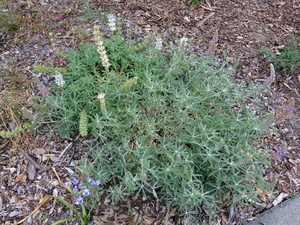 Two species of lupines mingle into a single clump in this Woodland garden. Chick Lupine (Lupinus microcarpus), toward the upper left, has pale yellow flowers and slightly brighter green foliage, while Summer Lupine (Lupinus formosus) , toward the lower right, has pale purple flowers and slightly grayer foliage. Photo by queerbychoice.
Two species of lupines mingle into a single clump in this Woodland garden. Chick Lupine (Lupinus microcarpus), toward the upper left, has pale yellow flowers and slightly brighter green foliage, while Summer Lupine (Lupinus formosus) , toward the lower right, has pale purple flowers and slightly grayer foliage. Photo by queerbychoice.
Silver Bush Lupine (Lupinus albifrons) is a shrub native to Woodland that grows to about 4 to 5 feet tall and 2 to 3 feet wide. It prefers full sun and good drainage. It is very sensitive to root disturbance and can be difficult to install into a garden from a nursery pot. It thrives on neglect but can be short-lived in gardens when it gets watering and attention. It is ranked 3 out of 10 on the Ogren Plant Allergy Scale, indicating a mild tendency to cause hay fever.
Miniature Lupine (Lupinus bicolor) is an annual or short-lived perennial that is native to Woodland and can grow to a little over 1 foot tall. Its flowers are usually bicolored, dark blue and white or sometimes blue and lavender or blue and pink. It prefers full sun. It is ranked 3 out of 10 on the Ogren Plant Allergy Scale, indicating a mild tendency to cause hay fever.
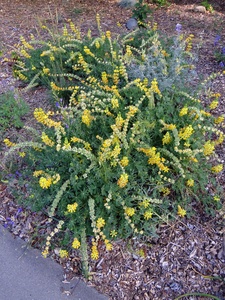 Chick Lupine (Lupinus microcarpus). with bright yellow flowers and deep green foliage, mingles in this Woodland garden with a young Silver Bush Lupine (Lupinus albifrons) at the top right of the clump, with purple flowers and much grayer foliage. Photo by queerbychoice.Summer Lupine (Lupinus formosus) is a perennial native to Woodland that grows up to 2.5 feet tall. Cattle farmers often eradicate it because it is poisonous to cattle. Younger plants are more poisonous than older ones. It prefers full sun. It is ranked 3 out of 10 on the Ogren Plant Allergy Scale, indicating a mild tendency to cause hay fever.
Chick Lupine (Lupinus microcarpus). with bright yellow flowers and deep green foliage, mingles in this Woodland garden with a young Silver Bush Lupine (Lupinus albifrons) at the top right of the clump, with purple flowers and much grayer foliage. Photo by queerbychoice.Summer Lupine (Lupinus formosus) is a perennial native to Woodland that grows up to 2.5 feet tall. Cattle farmers often eradicate it because it is poisonous to cattle. Younger plants are more poisonous than older ones. It prefers full sun. It is ranked 3 out of 10 on the Ogren Plant Allergy Scale, indicating a mild tendency to cause hay fever.
Chick Lupine (Lupinus microcarpus) is an annual native to Woodland that can grow up to 2.5 feet tall. Its flowers can be pink, purple, white, or yellow, depending on the variety. It prefers full sun. It is ranked 3 out of 10 on the Ogren Plant Allergy Scale, indicating a mild tendency to cause hay fever.
Sky Lupine (Lupinus nanus) is an annual native to Woodland that can grow up to 2 feet tall. It prefers full sun. It is ranked 3 out of 10 on the Ogren Plant Allergy Scale, indicating a mild tendency to cause hay fever.
Arroyo Lupine (Lupinus succulentus) is an annual native to Woodland that grows 2 to 4 feet tall and 3 feet wide. It can colonize disturbed areas. It prefers moist clay or heavy soils in full sun. It is ranked 3 out of 10 on the Ogren Plant Allergy Scale, indicating a mild tendency to cause hay fever.
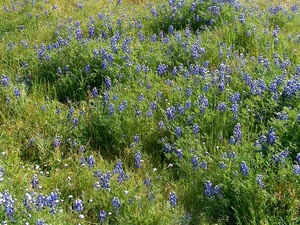 A field of Sky Lupine (Lupinus nanus) in the wild. Photo by queerbychoice.
A field of Sky Lupine (Lupinus nanus) in the wild. Photo by queerbychoice.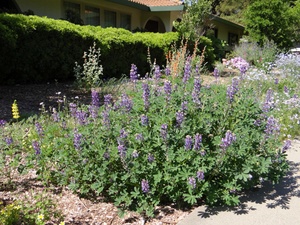 A large clump of purple-flowered Arroyo Lupine (Lupinus succulentus) is accompanied here by a single yellow flower of Chick Lupine (Lupinus microcarpus) at far left in this Woodland garden. Photo by queerbychoice.
A large clump of purple-flowered Arroyo Lupine (Lupinus succulentus) is accompanied here by a single yellow flower of Chick Lupine (Lupinus microcarpus) at far left in this Woodland garden. Photo by queerbychoice.
Native to Yolo County
Spider Lupine (Lupinus benthamii) is an annual native to the eastern part of Yolo County, starting just east of County Road 103. It grows a little over 2 feet tall and prefers full sun. It is ranked 3 out of 10 on the Ogren Plant Allergy Scale, indicating a mild tendency to cause hay fever.
Big Pod Lupine (Lupinus pachylobus) is an annual native to the Yolo County foothills, including the Capay Hills. It grows a little over 1 foot tall. It is ranked 3 out of 10 on the Ogren Plant Allergy Scale, indicating a mild tendency to cause hay fever.
Links
Wikipedia: Lupinus microcarpus
Wikipedia: Lupinus succulentus


